Comparative Myths of the Underworld Across Cultures: An Analysis of Afterlife Lore

Updated On: April 24, 2024 by Yasmin Elwan
Comparative myths of the underworld often examine the recurring themes found in the myths of various cultures. This concept serves as a metaphysical plane where souls journey after death, a realm that is both a continuation of life and a stark departure from it. By exploring mythology from around the world, we uncover the shared human experience of pondering what lies beyond this life, as well as the unique cultural interpretations of the afterlife. The systematic study of underworld myths reveals how different societies perceive the afterlife, the deities that govern it, and the trials faced by the souls of the departed.
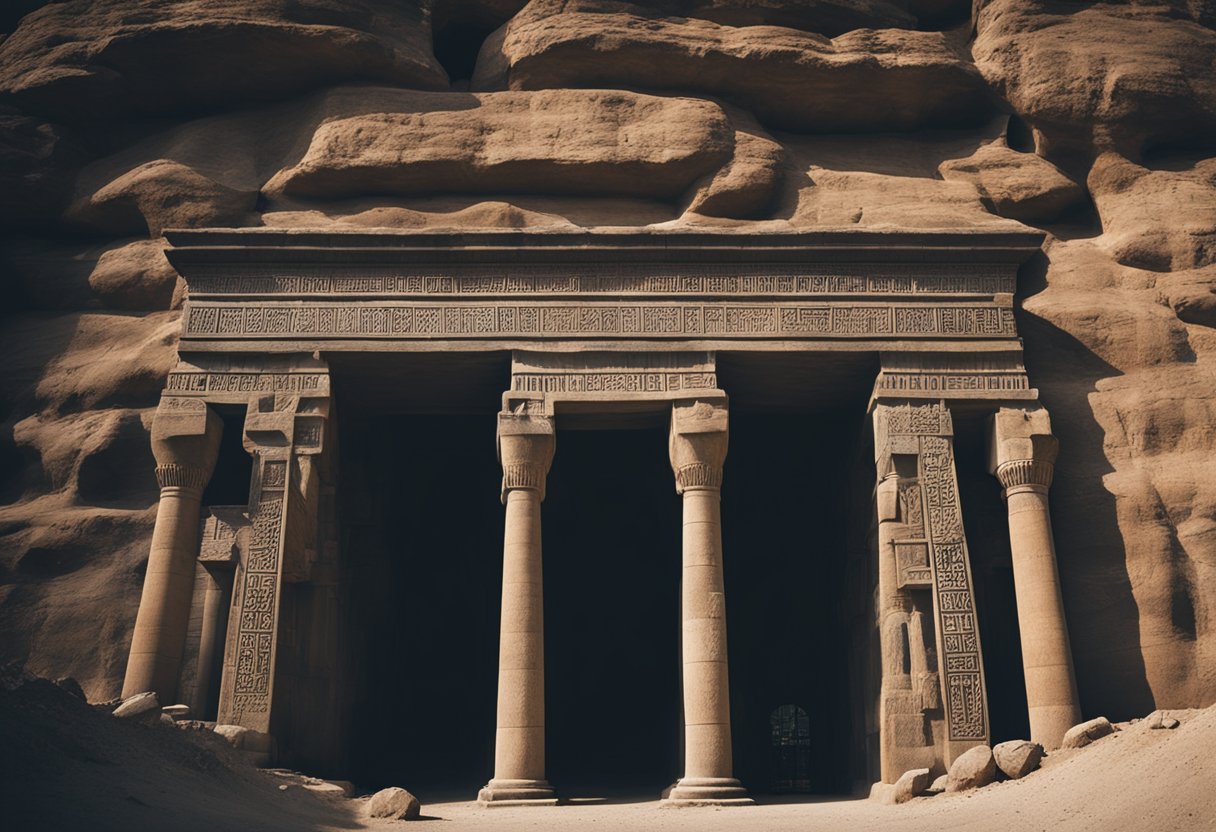
Over time, cultures have woven stories that reflect their understanding of morality, the afterlife, and the cosmos. Tales from Ancient Greece depict the underworld of Hades, governed by a god of the same name and his domain, Tartarus. Egyptian mythology, on the other hand, presents us with the sun god Ra’s nightly journey through the Duat, signifying rebirth and regeneration. Meanwhile, Christian and Roman traditions offer varied yet related views on hell, with visions of purgatory and eternal judgment. These narratives not only communicate religious and moral teachings but also convey deeper insights into the ways that humans across ages and continents have interpreted their existence and the afterlife.
Origins of Underworld Mythology

The concept of an underworld, a realm where souls depart after death, pervades many of the world’s mythologies. This shared notion might hint at a common psychological and cultural underpinning across societies. By examining these myths, we gain insight into how our ancestors sought to understand the mystery of life and death.
Anthropologists and historians have noted that underworld myths often reflect a culture’s values and social norms. The underworld of Greek mythology, known as Hades, presents a multifaceted realm where shades of the deceased exist in a sombre reflection of their earthly lives.
Meanwhile, other cultures have their distinct versions. The myth of Inanna from Sumerian mythology tells of her descent into the underworld, providing a historical example of such a narrative. These stories frequently serve to address human concerns about mortality and the fate of the soul.
Comparative mythology has shown that these stories, while unique in detail, share many common features. Our understanding of these realms has been enriched by interpretations through various academic disciplines, including anthropology and comparative religion.
- Cultures: Varying depictions of the underworld across societies.
- History: Evolution of underworld myths through time.
- Anthropologist: The use of these myths to decode cultural values.
Underworld myths serve as more than mere tales of afterlife; they are a testament to humankind’s quest for meaning beyond the observable world. Through comparative study, we continue to unravel the shared human experience enshrined within these ancient stories.
Greek Underworld: Hades and Tartarus
The Greek Underworld captivates with its complex layers and entities, of which Hades and Tartarus play central roles. Here, we’ll explore the dominion of the god of the dead and the abyss used as a divine prison.
Key Figures: Hades and Persephone
Hades assumes a principal position in Greek mythology as the ruler of the Underworld, a deity revered and often feared by the Greeks. His realm is not solely a place of torment but also of rest for the souls of the departed. Alongside Hades is Persephone, his consort, who presides over the Underworld for part of the year. Her story intertwines with the cycle of seasons and serves as an allegory for life, death, and rebirth. Their reign together over the Underworld maintains the balance between life and death.
Famous Myths: Orpheus and Eurydice
One of the most poignant tales from Greek mythology is that of Orpheus and Eurydice. Orpheus, famed for his musical prowess that could charm all living things and even stones, descends into the Underworld after his beloved Eurydice’s untimely death. His lyre playing softens the hearts of Hades and Persephone, convincing them to allow Eurydice to return with him to the world of the living, under one solemn condition – he must not look back until they reach the surface. Unfortunately, just before they reach the light, Orpheus looks back, and Eurydice is lost to him forever, highlighting the irrevocable finality of death in Greek thought.
Egyptian Afterlife: Journey to Duat

In exploring the mythology of Egypt, we find that the afterlife was a fervently detailed concept, with the journey to Duat being central to their beliefs. This perilous voyage required guidance from deities and adherence to sacred rituals as depicted in the Book of the Dead.
Gods of the Underworld: Osiris and Anubis
Osiris, the god of the afterlife, presided over the underworld, known as Duat. It was he who welcomed the spirits of the deceased. Osiris was believed to be the judge of the dead, and his favour was imperative for a safe passage.
Anubis, the jackal-headed god, was the protector of graves and the guide of souls. He was the one who conducted the ritual of the Weighing of the Heart. It was under Anubis’s watchful eye that the hearts of the dead were weighed against the feather of Ma’at to determine the worthiness of a soul to enter the afterlife.
Book of the Dead and Funerary Practices
The Book of the Dead was a collection of spells and instructions to assist the deceased in navigating Duat. These texts, often written on papyrus and included in the burial, were quintessential for overcoming the challenges post-mortem.
Funerary practices in Egypt were elaborate, with mummification serving to preserve the body for its eternal journey. Spells from the Book of the Dead were recited, and amulets placed amongst the wrappings to aid in the forthcoming trials within Duat.
In adhering to these meticulous rituals, the ancient Egyptians solidified their quest for immortality, weaving the fabric of their mythology into the very core of their culture.
Christian and Roman Conceptions of Hell
Our exploration of the underworld begins by delving into the vivid Christian imagery of Hell depicted in Dante’s “Inferno” and juxtaposing it with the multifaceted Roman myths of the underworld.
Dante’s Inferno: Nine Circles of Hell
In our analysis, Dante Alighieri’s seminal work, “The Divine Comedy,” provides a detailed cartography of Hell, structuring it into nine distinct circles. Each circle in Dante’s Inferno represents a particular sin and its corresponding punishment, escalating in severity. For instance, the second circle punishes those guilty of lust with eternal storms, while the traitors in the ninth circle are encased in ice. Dante’s work remains one of the most influential Christian perspectives on Hell, colouring much of our contemporary understanding of damnation and moral retribution.
Roman Myths of the Underworld
The Roman conception of the underworld, while sharing similarities with Christian Hell, presents a more complex structure. Unlike the Christian singular realm of torment, Roman mythology speaks of a multifaceted afterlife ruled by deities such as Pluto. The virtuous could find solace in the Elysian Fields, akin to a paradise, whilst the Fields of Punishment bore a resemblance to Hell for the wicked. This dualistic nature underscores the Romans’ nuanced view of the afterlife, as detailed in works from Vergil’s “Aeneid” to various artefacts from ancient cities. The Romans’ tales of the underworld reveal equally enduring narratives that resonate throughout Western culture.
Mythical Structures and Geographies in the Underworld
Our exploration into mythical underworlds reveals a rich tapestry of geographies and structures that various cultures have envisioned. These realms of the dead repeatedly emphasise gates as thresholds between the living and the deceased. For instance, in Greek mythology, the entrance to Hades is guarded by Cerberus, a multi-headed hound.
The cosmic tree, a concept found in numerous mythologies, often serves as a central axis within the underworld. Norse mythology’s Yggdrasil connects multiple realms, including the underworld known as Hel, signifying the interconnected nature of all worlds.
As for the realm of the dead itself, geographies differ widely across myths. The Greek Underworld is divided into various parts, including the Elysian Fields for heroic souls and Tartarus for punishing the wicked. It features rivers like the Styx and Acheron, which have roles crucial to the underworld’s structure.
Mesopotamian myths also describe a detailed underworld. The Epic of Gilgamesh mentions Irkalla, to which the hero Gilgamesh’s companion Enkidu descends, portraying the underworld as a point of no return yet a place holding esoteric wisdom.
This brief exploration only scratches the surface of the many geographies and structures conceived by different cultures to understand the afterlife. Despite the variations, common themes of impassable barriers, guiding symbols, and domains for the departed resonate across these mythological landscapes.
Ritual Practices and Symbolic Death
In examining rituals across cultures, we often find that practices surrounding symbolic death serve as a profound means of connecting the living with the spiritual realm. Symbolic death involves rituals that reflect a temporary state of transition, typically designed to promote spiritual renewal or transformation.
- Trance States: We explore trance states, which are integral to many shamanistic rituals. Individuals known as shamans enter trances to interact with spirits, seeking guidance or healing for their community. This trance-induced journey is viewed as a form of symbolic death, a temporary departure from the physical world to the realm of deities.
- Deities and Neo-Paganism: The role of deities in symbolic death is significant in numerous traditions. Neo-paganism, for instance, often features rituals that honour death and rebirth, reflecting the cyclic nature of life. Deities associated with the afterlife or underworld, such as Hecate or Osiris, are invoked to facilitate the soul’s journey and transformation.
Shamanic Rituals
- Preparation: Fasting, isolation, or use of hallucinogenic plants.
- Ritual: Drumming, chanting, and dance to reach altered states.
- Purpose: To gain insight, heal, or guide souls between worlds.
Symbolism in Rituals
- Objects: Masks or costumes to embody spiritual entities.
- Actions: Ritualistic ‘deaths’ symbolise the shedding of the old self.
- Outcomes: Renewed individuals with insights or resolutions.
In our communities, these practices are not mere superstitions but form a detailed tapestry of belief systems that offer solace and understanding of life’s cyclical nature. Engaging with such rites allows for a reassessment of life’s priorities, personal transformation, or community healing, cementing their importance across cultures throughout history.
Comparative Myths of the Underworld Deities
In this section, we explore the intricacies of underworld deities across various myths, focusing on their shared characteristics and the roles of their accompanying beasts and animals.
Shared Characteristics of Gods
Underworld gods across different cultures often exhibit omnipotence within their realms and a stern demeanour when dealing with souls. These deities are typically associated with judgement and the afterlife. For instance, the Greek Hades governs the underworld with strict fairness, while the Mayan god Xibalba presides over an underworld known for its trials and tribulations.
- Hades (Greek Mythology): Ruler of the underworld, personifying death and justice.
- Anubis (Egyptian Mythology): Guardian of the dead, overseeing mummification and the weighing of the heart.
- Yama (Hindu and Buddhist Mythology): First mortal who died, turned king of the dead, a judge of souls.
Role of Guardian Beasts and Animals
The presence of safeguarding beasts and animals is another common theme seen among the underworld myths. Dogs, in particular, are often depicted as guarding the thresholds of the nether regions.
- Cerberus (Greek Mythology): A multi-headed dog (often three-headed) serving as Hades’ loyal guardian at the underworld’s entrance.
- The jackal (Egyptian Mythology): Associated with Anubis, often depicted as guiding individuals to the afterlife.
- Guardian lions (Chinese Mythology): Symbolic protectors against evil spirits in the underworld.
These deities and their beastly companions underscore a universal belief in an overseer of the dead and enforcers to maintain order within the afterlife’s realm.
Transformation and Metamorphosis in Underworld Legends
In many cultures, transformation is a central theme in tales of the underworld. Characters often undergo profound changes, both physically and spiritually, as they navigate these mysterious realms.
In Greek mythology, Orpheus is a prime figure associated with such transformations. Noted for his ability to charm all living things with his music, Orpheus descends to the underworld in a brave attempt to retrieve his beloved Eurydice. His journey symbolises spiritual transformation, compelling him to confront the impermanence of life and the power of love over death.
Physical metamorphoses also occur frequently in underworld narratives. These storied changes often reflect inner growth or external punishment. For example, in some legends, those who commit hubris may be transformed into lesser creatures as a form of retribution, while others might find a new form through enlightenment or redemption within the shadowy confines beneath.
Greek myths convey that underworld journeys can lead to transformative wisdom, elucidating the deep-seated belief that knowledge is gleaned from the challenging passage between worlds.
We recognise in these legends a common thread where the descent is not merely an end but a potent beginning — a catalyst for change and enlightenment. Through our research, we continue to unveil how these transformative themes of underworld legends resonate with audiences across different cultures and epochs, reflecting our collective fascination with what lies beyond.
Cultural Significance and Universal Themes
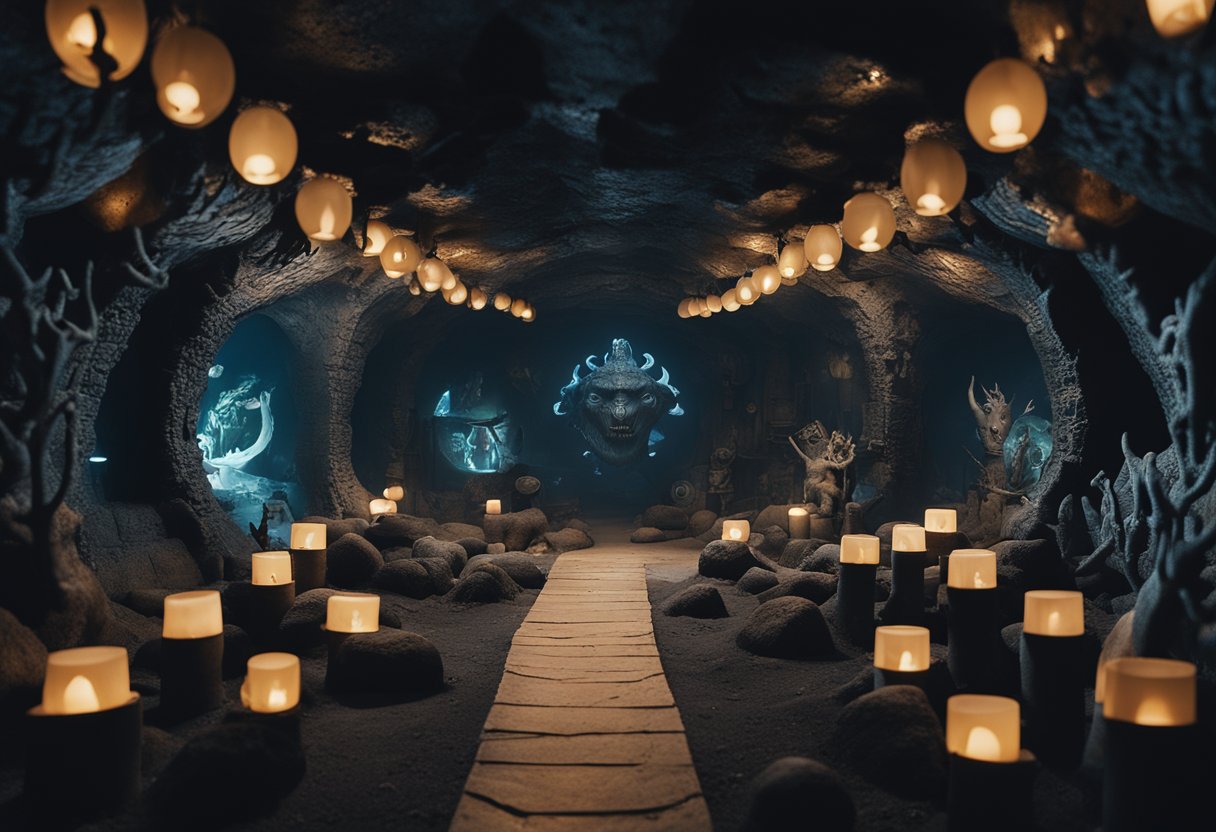
Underworld myths hold profound cultural significance, manifesting universally across various societies. They offer insights into the human experience—our quest to understand life, death, and the unknown. We see a recurring motif of descent into the underworld, an odyssey that reflects the natural human fascination with mortality and the afterlife.
Similarities and Shared Themes
- Journey: Many cultures depict a traversal into the underworld, symbolising the soul’s voyage after death.
- Trials: Heroes often face tests or challenges, illustrating the struggle of life’s journey.
- Rebirth: A common theme is the return to the living world, a metaphor for renewal or enlightenment.
Universality
Mythological narratives, such as the descent into the underworld, are not bound to any one culture. They reflect a shared quest for meaning, further suggesting a collective unconscious—a reservoir of experiences common to all humanity.
The Role of Mythology
The prevalence of underworld tales in media, even today, can be seen as a modern echo of ancient attempts to confront and personify the mysteries of existence. Myths grant us a backward gaze across time, letting us witness the concerns and beliefs that shaped our ancestors’ worldviews.
| Cultural Aspect | Significance |
|---|---|
| Rituals & Beliefs | Reinforces cultural values and provides a lens to view the human condition |
| Morality & Ethos | Offers a set of principles guiding good conduct and justice |
In essence, these stories form a cornerstone of our heritage, capturing the essence of what it means to be human, challenging adversity, and contemplating what lies beyond.
Mythic Heroes and Heroines: Katabasis
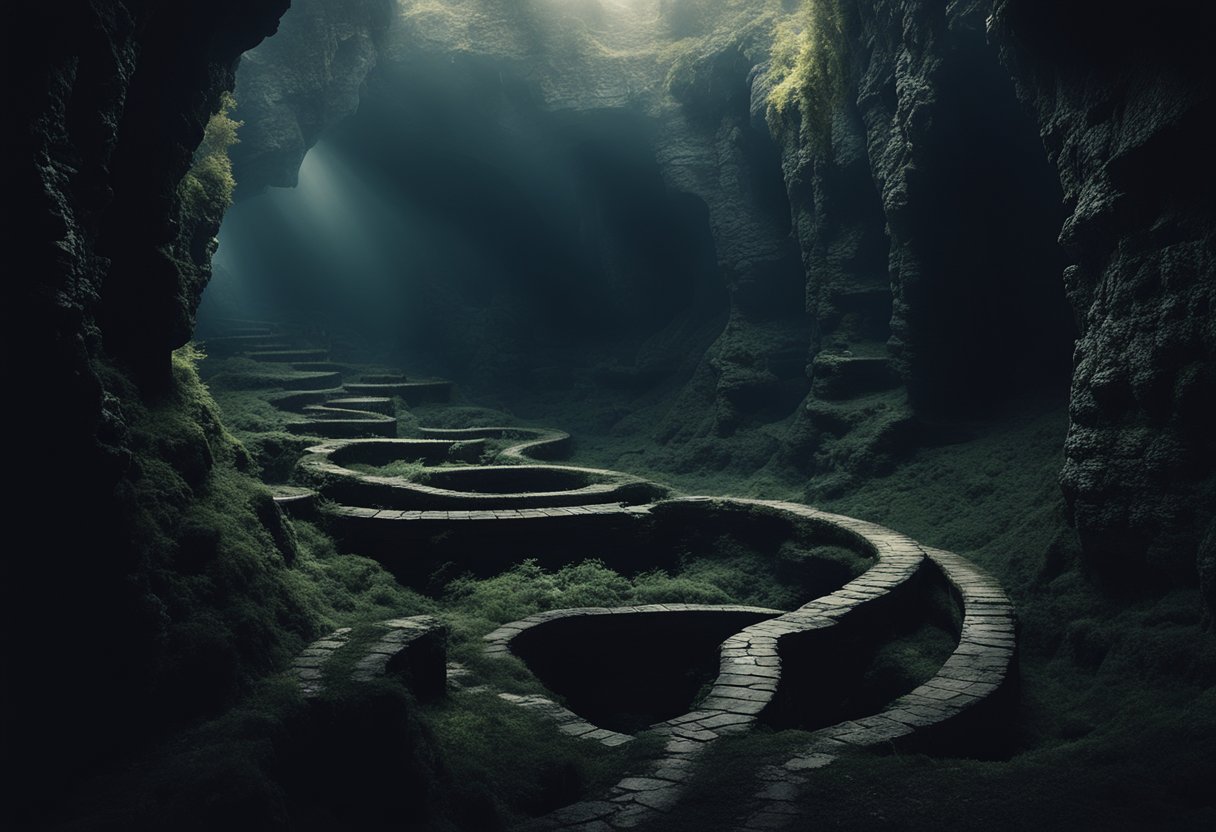
Katabasis, the descent to the underworld, is a pivotal theme in mythology where heroes venture into the realm of the dead. Their journeys are not just for personal gain but often serve a larger purpose in the mythic narrative.
Odysseus’ Nekyia
In Homer’s epic, “The Odyssey,” we follow the Greek hero Odysseus as he undertakes a nekyia, a ritual that allows him to consult the spirits of the dead. This act of katabasis is unique as Odysseus does not physically descend into the underworld but rather summons its inhabitants to gain knowledge to aid his return to Ithaca. His encounters with the shades of the past serve as a reflection on his journey and the consequences of hubris.
Aeneas’ Descent to the Underworld
In contrast, Aeneas, the Trojan hero of Virgil’s “Aeneid,” experiences a more literal katabasis as he physically descends into the Underworld. Aeneas’ journey is driven by his destiny to find what will become Rome. Guided by the Sibyl of Cumae, he meets various figures, including his deceased father, who expounds upon the future glories of Rome, imbuing Aeneas’ mission with a sense of grandeur and inevitability.
Influence on Literature and Modern Interpretations
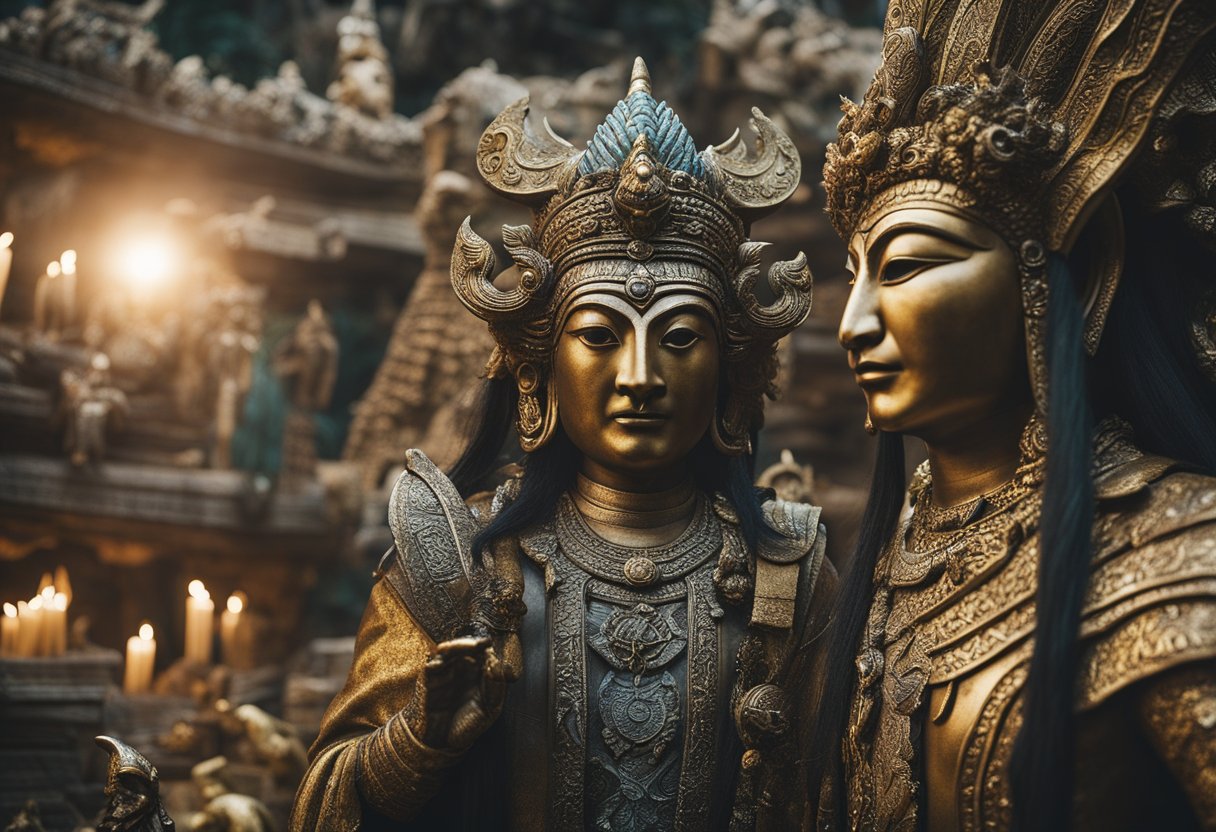
The mythology surrounding the underworld has been a rich source of inspiration for literature, permeating modern works with themes both ancient and perennial. Through scholarly analyses and creative reinterpretation, these myths have found new life in contemporary culture.
- Literature: The narrative traditions of underworld myths have been adapted with differing perspectives, incorporating discourses from postmodernism to postcolonialism. Our collective fascination with these tales continues to thrive in novels, poems, and plays, serving as a cultural archive of timeless human concerns and experiences.
- Claude Lévi-Strauss: His structuralist approach had profound implications for our understanding of myths. By analysing universal patterns in various cultural stories, including those of the underworld, we’ve gained insights into the human psyche and the underlying structures that govern our narratives.
- Psychoanalysis: Psychoanalytical readings of underworld myths have unravelled the subconscious layers within literature. These interpretations expose the deep-seated fears and desires that propel both the characters and, vicariously, the readers on a journey through harrowing yet illuminating landscapes.
- Epic of Gilgamesh: As one of the earliest works of literature, the Epic of Gilgamesh is instrumental in charting the course of underworld mythology. Its depiction of the hero’s descent and trials has set a precedent for the multitude of stories that follow in its wake.
Interpretations of these myths have evolved, reflecting contemporary values and concerns while paying homage to their origins. This continual re-imagining affirms our enduring connection to the themes of life, death, and what may lie beyond.
Frequently Asked Questions
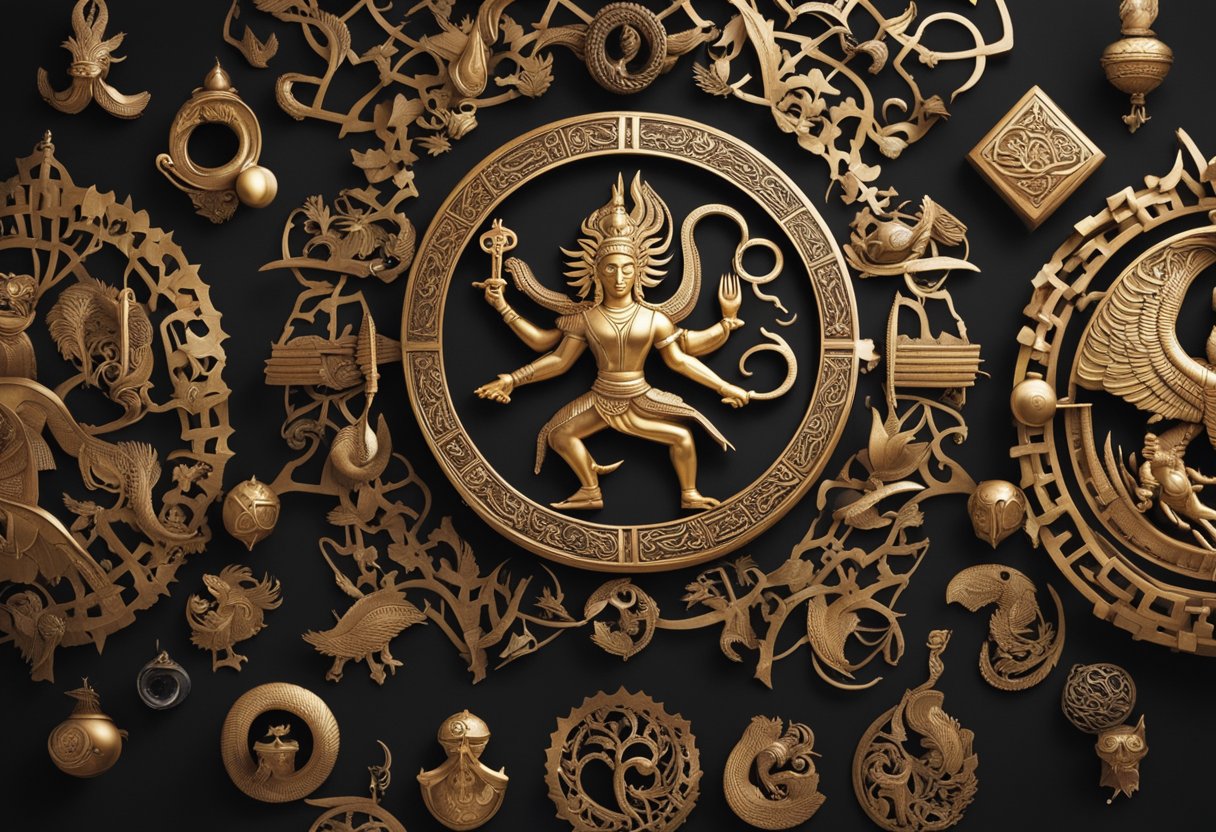
We’ve gathered some of the most common queries regarding the underworld myths from various cultures to provide insightful responses that illustrate the universal and distinctive aspects of these fascinating narratives.
What universal themes are present in the mythological underworlds of various cultures?
In mythological underworlds, themes of death, rebirth, justice, and morality are widely prevalent. These motifs reflect a shared human concern with the nature of existence and the afterlife.
How do the underworld realms in different cultural myths compare and contrast?
Across different cultures, underworld realms can be places of torment or rest, reflective both of punitive measures for the wicked and rewards for the virtuous. Comparative mythology studies reveal a spectrum of afterlives, from the Greek Hades to the Norse Hel.
In what ways do the rulers of the underworld in assorted mythologies reflect their respective cultures’ values?
The characters of underworld rulers, such as Hades in Greek mythology or Osiris in Egyptian myths, embody the cultural values surrounding justice and authority. Their roles often highlight the importance of moral conduct and the maintenance of cosmic order.
What roles do heroes or mortals play in the myths of the underworld across different societies?
Heroes or mortals often embark on underworld journeys to seek wisdom, meet loved ones, or complete a heroic quest, showcasing their bravery and providing a narrative for discussing existential dilemmas and life cycles.
How is the concept of the afterlife explored through the underworld myths of disparate traditions?
Underworld myths are a means to articulate beliefs about the afterlife, offering insights into a culture’s views on existence beyond death and the moral implications for one’s actions during life.
Can parallels be drawn between the underworld journeys in mythologies of diverse regions?
Indeed, parallels exist, such as the transformative trials faced during these journeys, as figures like the Sumerian Inanna or the Greek Orpheus confront trials that mirror life’s challenges and highlight the profound journey of self-discovery.






